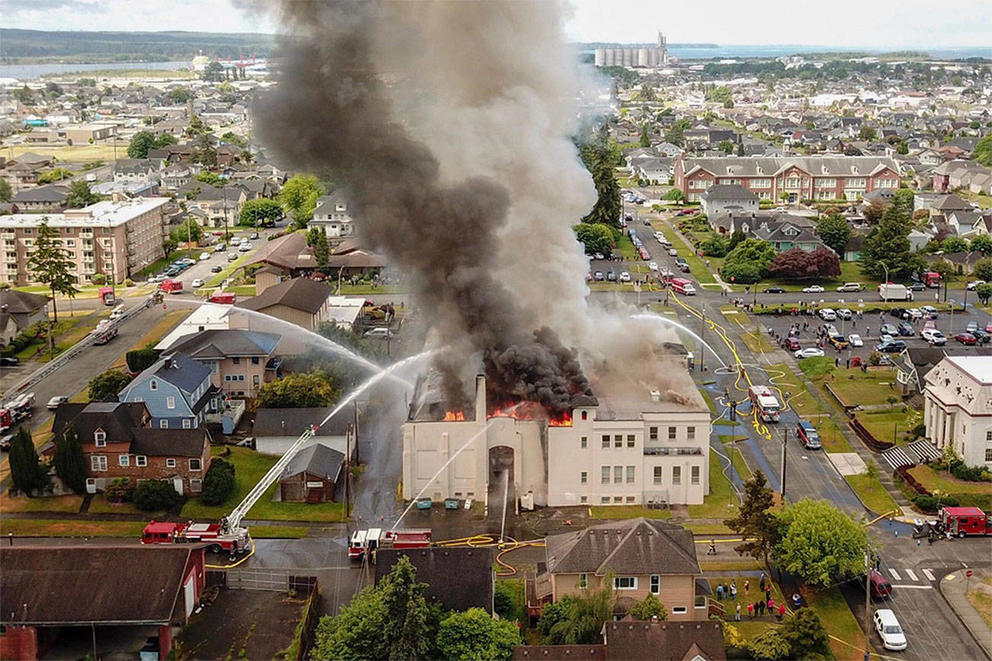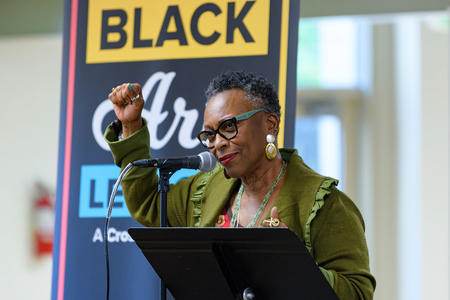Over the years, the list has evolved. In 2009, it was a pretty straightforward assessment of our wrecking of historic structures (that year, for instance, the state Department of Natural Resources actually gave Hollywood producers permission to burn down a historic farmhouse). Since then, the destruction wrought by our neglect of climate change and the environment has become more obviously a part of the problem.
My hope is that this series will inspire better stewardship in the future if we look at the ways we are failing the past now. In that spirit, my picks for 2018 Heritage Turkeys Awards.
Tahlequa’s Tragedy
No heritage event this year was more dramatic or poignant than when the Southern Resident orca known as Tahlequah paraded her dead calf throughout Northwest waters for 17 days last summer in what National Geographic called a “sad spectacle” of mourning. It triggered action and renewed concerns about the health of the endangered orcas that frequent Puget Sound, whose numbers have been reduced to their lowest number in 30 years (about 74). Stress, starvation and exposure to toxins are all cited as problems and impact the ability to conceive and raise their young. Some observers said the grieving mother was calling our attention to the crisis. Chief Bill James of the Lummi Nation said, “She’s giving us a sign — our native people know how to read that.”
The threats to the orcas and the Salish Sea are real and ongoing: Diminishment of the orcas’ major food source, Chinook salmon, is key. Pollution and chemical exposure are a factor. The proposed Trans Mountain Pipeline in Canada poses threats from potential oil spills and noise from increased shipping in environmentally vulnerable home waters. Many of the fixes outlined by Washington’s Orca Recovery Task Force released this fall are long-term and difficult, including breaching multiple Snake River dams to increase the salmon supply, dealing with contaminants and stormwater runoff, even placing a moratorium on orca-watching trips. Can we do all that?
In his recent book on the history of orca captures, Jason Colby of the University of Victoria noted the irony that the first captures of Northwest killer whales for aquariums in the mid-1960s generated great sympathy for the species, which was previously regarded as a predatory pest. While we no longer hunt wild orcas and now view them as regional icons, we have never faced up to what our “love” for them means in terms of making the sacrifices to keep them alive. That is a hard takeaway from Tahlequa’s message, and her dead calf’s body.
The “Cobain” Conflagration
This summer, the Northwest choked on wildfire smoke, but fire also took a toll on local heritage. In June, the Aberdeen Museum of History, located in a historic armory, caught fire. The fire made national headlines. The cause was never definitively determined, but the effects were devastating: The museum destroyed thousands of artifacts lost to the flames and many more damaged by smoke and water. The casualties included an exhibit and original artwork by grunge rocker and native son Kurt Cobain, as well as historic documents and artifacts of one of the Northwest’s most fascinating working class cities. Staff from the Washington State Archives rushed to the scene to help salvage, repair and store some of what could be saved. In November, the city decided to demolish what was left of the historic structure and a new museum is planned. A major fire at the national museum in Brazil this year has raised concerns at the vulnerability of museums worldwide in the era of climate change, tight budgets and, sometimes, neglect.
Climate Change Depression
New studies suggest that climate change’s impact on indigenous communities, and the potential loss of cultural and historic knowledge, is being heavily impacted, notably but not limited to Alaskan native peoples who are on the front lines of the warming Arctic: declining permafrost, shifts in animal migration patterns (like the caribou), disruptions to fisheries, melting glaciers, extreme weather events. According to the latest national report on climate change, “Climate change is a common concern among Alaskans and is associated with feelings of depression and uncertainty about the potential changes to communities, subsistence foods, culture, and traditional knowledge and the potential of relocation from long-established traditional sites. … This is especially true of Indigenous peoples, who have a deep connection to their home areas, often described as sense of place. Over generations, Indigenous communities have developed extensive knowledge about their areas and the plants and animals with which they share an ecosystem. As the effects of climate change are felt in the landscape, many Alaska Natives feel a sense of personal loss as the familiar has become unpredictable and sometimes strange.”
Tombstone Sex, Dead Calves and Damaged Petroglyphs
The amount and breadth of vandalism of heritage and historic sites in the Northwest is sobering and disgusting, whether motivated by racism, greed, ignorance or utter selfishness. Here’s just a sampling of this years’ news reports: vandals in Olympic National Park carving up ancient petroglyphs associated with the Makah tribe in the Ozette area; the trashing of an Oregon Trail Interpretive Park called Blue Mountain Crossing in Oregon that included theft of artifacts and ATV damage to the landscape; the ongoing damage to the Milner Historic Recreation Area in Idaho, including graffiti on landforms and the dumping of some 30 dead calves (!) and trash; damage to a historic home in Sooke on Vancouver Island; vandalism at a First Nations burial site in British Columbia with a racist slur; and damage to historic Jewish cemeteries in North Seattle, with accusations that the problem stemmed from the city’s failure to deal with homelessness. The cemetery problems included vandalism, garbage, feces and drug paraphernalia — and a couple having sex on a tombstone. People, people, people!
What He Did on His Drunken Summer Vacation
This summer, the National Park Visitor from Hell Award goes to the Pendleton, Oregon, man who went on a drunken, animal harassment tour of parks. In less than a week, 50-year-old Raymond Reinke managed to get himself arrested or cited in Grand Teton, Yellowstone and Glacier national parks for drunkenness, disorderly conduct, interfering with law enforcement, and getting out of his car to harass and taunt bison. Apparently, his trip was a “last hurrah” before entering rehab. Now in addition to treatment, Reinke was sentenced to 130 days in jail by a federal court and banned from the three parks for five probationary years. Reinke reportedly said, “I’m sorry to the buffalo. He didn’t deserve what I did to him.” He was very lucky the buffalo showed more restraint than he did.
You Deserve a Demolition Today!
Believe it or not, early McDonald’s restaurants are considered historic — precedent-setting, 1950s and ’60s modernist architecture featuring the golden arches that launched a global burger colossus. So-called Googie architecture has gain new respect, but it’s not uncontroversial. Readers of Crosscut will remember the huge brouhaha that erupted when the city of Seattle, for example, designated as a landmark a former Manning’s and Denny’s in Ballard. It was torn down anyway. Preservationists did not save the third-oldest McDonald’s in the country, located on Southeast Powell Boulevard in Portland. It opened in 1962. This early McDonald’s was compact and efficient like any Dick’s Drive-in, and embodied the era of pre-Big-Mac-scale burger joints. Such McDonald’s are exceedingly rare now as the stores have mostly been updated. This one was turned into an events space back in the 1980s. Its demise in April did not go without notice. In a lament in Willamette Week, a writer served up this explanation of what such demolitions mean in Portland. “In a city changing so fast it can be difficult to recognize a street from one year to the next; almost anything can become hallowed ground. Our love for our own collective memory is outsized, perhaps even embarrassing. But it’s also how our city maintains its character.”
Portland isn’t the only city where this is happening. A majority of the Seattle Landmarks Board members present at a meeting earlier this year voted to protect the Googie-designed Spud’s Fish & Chips at Green Lake, but couldn’t muster the five votes necessary for the designation to stick, according to Eugenia Woo of the preservation nonprofit Historic Seattle, clearing the way for the structure to be demolished.
A “Demented Social Club”
Prosecutors in Washington and Oregon have filed scores of charges against a group of hunters, men and women, who were intent on slaughtering wildlife illegally for the sheer fun of it and documenting their kills with photographs and video. The charges included what The Seattle Times called “gruesome hunts,” sometimes using dogs, to kill deer, bobcats, elk, bear and small mammals, mutilating bodies and often taking their heads and leaving carcasses to rot. Some videos apparently show dogs chewing on still-living animals. Investigators have called it the largest and most complex poaching ring ever. Charges have been brought in at least seven counties, including Lewis, Pacific and Skamania in Washington and Wasco, Clatsop, Lincoln and Clackamas in Oregon. Ten suspects are from Cowlitz County. Some convictions have been obtained, other trials are still to come, involving members of what a member of the Oregon State Police Wildlife Division called a “demented social club.” According to the Longview Daily News, the poaching ring allegedly operated frequently in the Gifford Pinchot National Forest in southwestern Washington, named for the man who urged the “wise use” of our natural resources.
Showbox Showdown
One of the good things that happened this year was the public hue-and-cry over the proposed demolition of the Showbox Theater in downtown Seattle. The sale of the building that houses the Showbox to a major developer seeking to build a tall high-rise on First Avenue across from the Pike Place Market generated instant alarm even outside the preservation community. The theater, running since the Great Depression, has had on its stage everyone from Duke Ellington to Pearl Jam. It is treasured across generations for its part in the city’s cultural life. Outrage over its possible destruction caused the city council to declare the property temporarily part of the Pike Place Market Historic District, and Historic Seattle and other groups sought to landmark the theater. A lawsuit from the owners against the city has ensued. The theater’s ultimate fate is undetermined, and it could still be demoed.
While the outrage over the possible loss of the Showbox was spontaneous and genuine, it highlights a number of problems. Why haven’t people acted more aggressively to preserve parts of First Avenue where major development — like the 14-story hotel planned for the site of the Hahn Building at First and Pike — will impinge on the historic integrity of the Pike Place Market experience? Why hasn’t the city been able to fully and more quickly enact, like San Francisco, a commitment to heritage designations that can be tools to protect long-term historic businesses and uses, in addition to architecture? Why can’t the city be more professionally proactive in seeking to identify and protect potential landmarks citywide, instead of waiting for preservationists and developers to submit ad hoc proposals on their own? Can there be meaningful mitigations for historic properties that cannot be saved? Can we have our treasures and our high-rises too? The Showbox raises many questions that need to be asked and answered.




